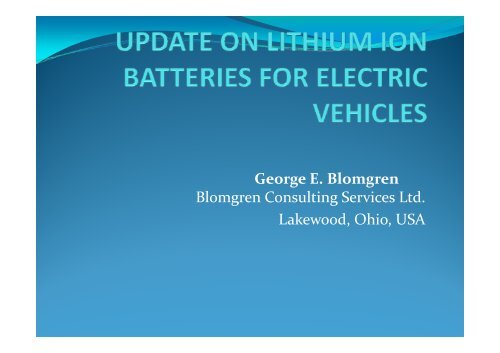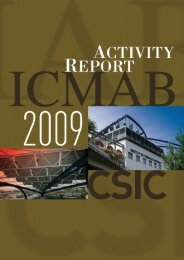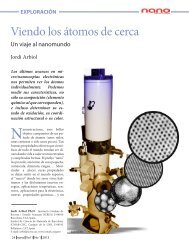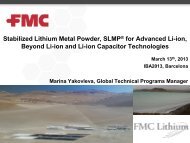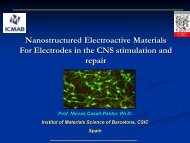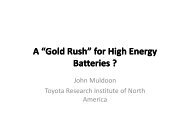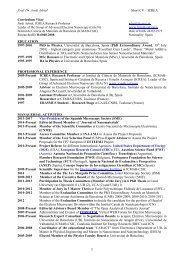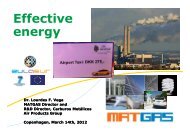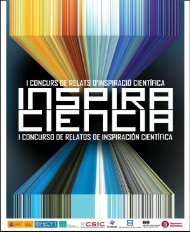G E Bl George E. Blomgren Blomgren Consulting Services Ltd. L k d ...
G E Bl George E. Blomgren Blomgren Consulting Services Ltd. L k d ...
G E Bl George E. Blomgren Blomgren Consulting Services Ltd. L k d ...
- No tags were found...
You also want an ePaper? Increase the reach of your titles
YUMPU automatically turns print PDFs into web optimized ePapers that Google loves.
<strong>George</strong> E. <strong>Bl</strong>omgren<strong>Bl</strong>omgren <strong>Consulting</strong> <strong>Services</strong> <strong>Ltd</strong>.Lakewood, Ohio, USA
Projection of lithium ion batterytransportation revenue from Pike ResearchGlobal sales of 3.8 M ev andpev by 2020 projected by PikeResearch
Lux Research predicts that lithium‐ion battery supply will reach about30GWh by 2020, while demand could be as low as 2GWh in the worstscenario, and 20 GWh in the best.(Source: Lux Research)
New Plug‐in Vehicle Sales in US by quarter (sourceArgonne National Laboratory)
New Hybrid Vehicle Sales in US by year (sourceEVs Roll)
2020 Sales Projections by area• Pike Research forecasts that by 2020 more than 1.8million BEVs will be on Europe’s roadways, along with1.2 million PHEVs and 1.7 million HEVs.• Pike Research also forecasts that there could be asmany as 1.8 million plug‐in electric vehicles on U.S.roads by 2020• Pike sees China taking the lead in terms of marketsize, with growth really taking off from 2013 onwardthrough that decade. By 2020, Asia Pacific is expectedto become the world’s largest PEV market
Geometry and placement ofbattery in evs, pevs, and hevs.Wide variety of placement, but generallyWide variety of placement, but generallynot in engine compartment
The Nissan Leaf’s 480‐lb battery pack is made up of 48stackable lithium‐ion modules.(Source: Nissan)
The Nissan Leaf's pack resides under the floor.(Source: Nissan)
Chevy Volt's T‐Shaped BatteryPack (Source: General Motors)
Chevrolet Volt battery location(Source GM)
Spark's btt battery configuration will differ from that t of the Volt, Vltresiding in the rear of the vehicle.(Source: GM)
Toyota's Prius PHV plug‐in uses 288 cells in its lithium‐ion batterypack, and employs 42 temperature t sensors, new ductwork, andthree fans for cooling.(Source: Toyota)
Prius Plug‐in placement in rear of trunk (sourceToyota)
Tesla's Model S uses a flat battery pack (at bottom) that contains at least7,000 small 18650‐type batteries, each measuring 18mm in diameter byabout 65mm long.(Source: Design News)
2013 Ford Focus Electric batteryMounted over rear axleFront wheel drive (Source Ford)A 23kWh, high‐voltage, h lithium‐ion i battery systemAdvanced liquid heating/cooling regulates batterytemperatureHl Helps maximize i battery life and miles from eachcharge
2012 Honda Civic Hybrid lithium ion battery in rear seat2012 Honda Civic Hybrid lithium ion battery in rear seat(Source Honda)
US Hybrid Sales for US ProducersBattery Size(kWh)BatteryChemistryBatterySupplierUSA EPA Combinedcity/hwy gasoline(mpg/kpl)Mfr Model CY 11 CY 2012 CY 12 vs 11LacrosseBuick Hybrid 1,801 12,010 566.90% 05 0.5 Li Ion Hitachi 29Buick Regal Hybrid 123 2,564 1984.60% 0.5 Li Ion Hitachi 29EscaladePrimearthCadillac Hybrid 819 708 ‐13.60% 1.8 NIMH PEVE) 21Chevrolet Malibu Hybrid 24 16,664 69333.30% 0.5 Li Ion Hitachi 29ChevroletSilveradoHybrid 1,001 469 ‐53.10% 1.8 NIMHPrimearthPEVE) 21Chevrolet Tahoe Hybrid 519 533 2.70% 18 1.8 NIMHPrimearthPEVE) 21Ford C‐Max Hybrid ‐ 10,935 N/A 1.4 Li IonPanasonic(Sanyo) 47FordEscape Hybrid(No longeravailable) 10,089089 1,441 ‐85.70% 18 1.8 NIMHPanasonic(Sanyo) 32Ford Fusion Hybrid 11,286 14,100 24.90% 1.4 Li IonPanasonic(Sanyo) 47GMC Yukon Hybrid 598 560 ‐6.40% 1.8 NIMHPrimearthPEVE) 21PrimearthGMC Sierra Hybrid 164 471 187.20% 1.8 NIMH PEVE) 21Lincoln MKZ 5,739 6,067 5.70% 1.8 NIMHPanasonic(Sanyo) 45Total US 32,163 66,522 107%US producers are transitioning to lithium ion from NIMH. Asian producers still sticking with NIMH.
US Hybrid Sales for Asian ProducersMfr Model CY 11 CY 2012 CY 12 vs 11Battery Energy(kWh) or Power(kW)BatteryChemistryBattery SupplierCombinedcity/hwygasoline(mpg/kpl)Acura ILX Hybrid ‐ 972 NA 20 kW NA<strong>Bl</strong>ue Energy (JVHonda Civic Hybrid 4,703 7,156 52.20% 20 kW Lithium ionof GS Yuasa andHonda) 44Honda CR‐Z 11,330 4,192 ‐63.00% 20 kW Lithium ion<strong>Bl</strong>ue Energy (JVof GS Yuasa andHonda) 37Honda Insight 15,549 5,846 ‐62.40% 0.6 kWh NIMH Sanyo 42Hyundai Sonata 19,673 20,754 5.50% 1.4 kWh Lithium ion LG Chem 36Infiniti M Hybrid 378 691 82.80% 1.3 kWh Lithium ion AESC 29Kia Optima Hybrid 403 10,084 2402.20% 1.4 kWh Lithium ion LG Chem 36Lexus CT200h 14,381 17,671 22.90% 1.3 kWh NIMH PEVE 42Lexus ES 300 Hybrid ‐ 7,041 NA 1.6 kWh NIMH PEVE 40Lexus GS 450h 282 607 115.20% 1.6 kWh NIMH PEVE 31Lexus HS 250h 2,864 649 ‐77.30% 1.3 kWh NIMH PEVE 35Lexus LS 600h 84 54 ‐35.70% 1.6 kWh NIMH PEVE 20Lexus RX 400 / 450 h 10,723 12,223 14.00% 1.6 kWh NIMH PEVE 30Toyota Avalon Hybrid ‐ 747 NA 1.6 kWh NIMH PEVE NAToyota Camry Hybrid 9,241 45,656 394.10% 1.6 kWh NIMH PEVE 41HighlanderToyota Hybrid 4,549 5,921 30.20% 1.87 k NIMH PEVE 28Toyota Prius Liftback 128,064 147,503 15.20% 1.3 kWh NIMH PEVE 50Toyota Pi Prius V 8,399 40,669 384.20% 13kWh 1.3 NIMH PEVE 50Toyota Prius C ‐ 35,733 NA 0.94 k NIMH PEVE 50Total Asia 234,343 364,362 55%
US Hybrid Sales for European ProducersMfr Model CY 11 CY 2012 CY 12 vs 11Battery Size(kWh)BatteryChemistryBatterySupplierCombinedcity/hwygasoline(mpg/kpl)Audi Q5 Hybrid ‐ 270 NA 1.3 Lithium ion Sanyo 26ActiveHybrid 3BMW (335ih) ‐ 402 N/A 13 1.3 Lithium ion A123 28BMWBMWActiveHybrid 5(535ih) ‐ 404 N/A 1.3 Lithium ion A123 267‐SeriesActiveHybrid 338 231 ‐31.70% 1.3 Lithium ion A123 25Mercedes S400HV Hybrid 309 121 ‐60.80% 0.9 Lithium ion Saft 21PorscheCayenneHybrid 1,571 1,180 ‐24.90% 1.7 NIMH Sanyo 21Panamera SPorsche Hybrid 52 570 996.20% 1.7 NIMH Sanyo 25Volkswagen Jetta Hybrid ‐ 162 N/A 1.1 Lithium ion Sanyo 45Volkswagen Touareg Hybrid 390 250 ‐35.90% 1.7 NIMH Sanyo 21Total Europe 2703 3324 23%Low sales in US, but dominated by lithium ion. Mostly luxury hybrid vehiclesimported to US from Europe
US Sales for Plug‐in and Battery electric vehiclesManufacturer Model CY 11 CY 2012 CY 12 vs 11Battery Size(kWh)BatteryChemistryBatterySupplierElectric range(miles/km)Combinedcity/hwygasoline(mpg/kpl)BMW ActiveE ‐ 671 N/A 32 Lithium ionSB LiMotive(now RobertBosch BatterySystems) 94/151 N/ABYD Qin _ _ _ 10 Lithium ion BYD 31/50 _BYD e6 BEV _ _ _ 60 Lithium ion BYD 200/321 N/AChery S18 _ _ _ 40 Lithium ionWanxiangGroup 93/150 N/AChevrolet Volt 7,671 23,461 205.80% 16.5 Lithium ion LG Chem 38/61 37/15.780 to 90/130Chevrolet Spark New 20 Lithium ion A123 to 140 N/AFisher Karma Unknown 20 Lithium ion A123 33/53 20/8.5Ford C‐Max Energi ‐ 2,374 N/A 7.6 Lithium ion Panasonic 21/34 43/18.3Ford Focus 8 685 8462.50% 23 Lithium ion LG Chem 76/122 N/AHonda Fit EV ‐ 93 N/A 20 Lithium ion Toshiba 82/131 N/AHondaAccord PluginHybrid New 6.75 Lithium ion<strong>Bl</strong>ue Energy(JV of GSYuasa andHonda) 13/21 46/19.6Continued next slide
US Sales for Plug‐in and Battery electric vehicles(continued)Manufacturer Model CY 11 CY 2012 CY 12 vs 11Battery SizeBatteryBatteryElectric rangeCombined city/hwy(kWh) Chemistry Supplier (miles/km) gasoline (mpg/kpl)Mitsubishi i 80 588 635.00% 16 Lithium ion Toshiba 62/99 N/AMitsubishi Outlander New 12 Lithium ion 37/62Nissan Leaf 9,674 9,819 1.50% 24 Lithium ionAESC (JV ofNissan ‐ NEC ‐NEC Devices) 73/117 N/ALi‐Tec (JV ofSmart forTwo EV 388 139 ‐64.20% 17.6 Lithium ionDaimler ‐Evonik) 68/109 N/ATesla Model S* ‐ 2,400 (Est) N/A 40, 60, 85 Lithium ion PanasonicNA, 208,265/NA, 338,431 N/AToyota Prius Plug In ‐ 12,750 N/A 4.4 Lithium ion Panasonic 18‐Nov 50/21.3Toyota RAV4 EV ‐ 192 N/A 41.8 Lithium ionTesla(Panasoniccells) 100/161 N/ACodaAutomotive Sedan ‐ Unknown N/A 31 Lithium ion Lishen 88/141 N/ATotal 17821 53172 198%
US EPA website: hybrid vs. non‐hybrid comparisonbetween similarly equipped vehiclesFord Fusion: hybridvs. standard int.combustion engineFord fusion hybrid haslithium ion batteryHybrid Non‐hybrid DifferenceMSRP $27995 $24515 $3480Combined mpg 46.8 26.2 20.6Fuel savings/mo $78.7Fuel savings/yr $944Gallons fuel/yr 320 572 152Fuel cost/yr $1202 $2147 $944Years to payback 3.7Conditions: 15000 mi/yr, 55 city/45 highway, h $3.75 per gal. fuel cost
Hybrids vs. Plug‐in hybrids vs. EV• In general, hybrids compare favorably with non‐hybrids with relativelysmall incremental costs and 10 to 40% fuel improvement• Micro hybrids have only modest improvement in fuel use• Mild hybrids are intermediate, with full hybrids giving largest savings• Plug‐ins have better fuel savings , but incremental costs are higher sopayback is longer• The optimum electric range for different driving patterns is still notsettled ld ‐ EPA web site can be used to personalize the driving ii pattern aswell as total miles and fuel costs• EVs are not selling well and are expensive because of battery costs.• Industry is reorienting toward plug‐in hybrids in order to improve sales• Fuel standards may entice some manufacturers to go with losses in evsales in order to satisfy requirements in US and other countries• If battery costs come down as predicted, ev sales should benefit themost, but plug‐ins will also benefit, particularly if power capabilityincreases
Cell Properties for Asian ProducersBatteryCellElectrodeDeveloper Country Designation Cell Type chemistryAESC Japan L3‐10<strong>Bl</strong>ue Energy Japan EH‐6NominalVoltageCapacity(V) (Ah) Weight (kg) Volume (l)SpecificEnergy(Wh/kg)EnergyDensity(Wh/l)Laminated/flat carbon/LMO 3.6 13 0.527 0.277 89 171Wound/prismatic carbon/NMC 3.7 6 0.331 0.194 67 114BYD China Polymer/flat carbon/LFP 3.2 50 ? 0.92 ? 174EIG Korea C020 Polymer/flat carbon/NMC 3.65 20 0.428 0.202 173 360HitachiVehicleEnergy Japan Generation IVLG Chem Korea E2 Polymer/flatWound/prismatic carbon/LMO 3.6 4.8 0.24 0.194 72 123carbon/mixedcathode 3.7 10 0.243 0.135 152 273Lishen China LP2770108ab Prismatic carbon/LFP 3.2 13.5 0.42 0.224 102 146LithiumEnergyJapan Japan LEV50Rectangular /prismatic carbon/LMO 3.7 50 1.7 0.865 108 213Rectangular /Toshiba Japan SCiB prismatic LTO/LMO 23 2.3 20 051 0.51 0.296 90 177LMO –lithium manganese oxide, NMC –nickel manganese cobalt, LFP –lithium ironphosphate, NCA –nickel cobalt aluminum oxide
Battery Properties for US and European ProducersBatteryDeveloperCountryCellDesignationCell TypeElectrodeChemistryNominalVoltage(V)Capacity(Ah) Weight (kg) Volume (l)SpecificEnergy(Wh/kg)EnergyDensity(Wh/l)A123 US AMP20 Pouch/flat carbon/LFP 3.3 20 0.5 0.263 124 @ 3.1V 236carbon/MixedEnerdel US C175‐360 Pouch/flat Oxide 3.6 17.5 0.43 0.252 147 250JohnsonControlsUSPL27M(Plan for4Q2013)Rectangular/prismatic Graphite/NMC 3.65 27 ? 0.338 ? 291Saft France 41M Cylindrical Graphite/NCA 3.6 41 1.07 0.51 139 289DowKokkam US HE 40 Pouch/flat carbon/NMC 3.6 40 0.87 0.483 166 298About 170 Wh/kg for NMC with adequate power and pouch cell7 / g q p pUp to 120 Wh/kg for LFP in pouch cell, about 100 for LMOCylindrical lowest in energy, coiled prismatic intermediate, pouch cell highest
Ford Presentation by Nancy Gioia July, 2010Improvements are clearly needed to have sufficiently good technology and lowy y g gyenough cost to have a mass market, customer driven product in evs and phevs!Note the increased power capability needed for lower range plug –in vehicles
Cost projections for EV batteries from various sourcesSourceDateCost now(US$/kWh)Projection 2015(US$/kWh)Projection 2020(US$/kWh)Projection 2025(US$/kWh)Projection 2030(US$/kWh)McKinsey & Co. Jul, 2012 600 200 160<strong>Bl</strong>oombergNew EnergyFinance Apr. 2012 689 150Ford Apr. 2012 522‐650Institute ofInformation380 (Cell basis)120 (Cell basis)Technology(Takeshita) Mar. 2012 532 (cellx1.4)170 (cellx1.4)BYDPresentation 2011 300 205Element EnergyReport to CCC(UK) Mar. 2012 725 320US DOE goals 2012 1000 in 2008 300 125 in 2022If t b b ht t l t DOE l th kt ill b fitIf costs can be brought to close to DOE goals, the ev market will benefitsubstantially
Conclusions• Hybrid vehicles are now well established in the marketwith over 3% penetrlation in US light vehicles.• Both NIMH and Li ion will contribute and most vehicles willrequire at least a stop‐start technology and even mild hybridsbidwill come on strong. Payback time looks very good for fullhybrids.• Plug‐in hybrids will continue to develop and will benefitsubstantially from cost reductions in Li ion batteries.• Consumers will have to get used to plugging in every night ihand be more aware of range and acceleration to get maximumbenefit• Li ion batteries will certainly come down in price. Thesurvivor companies will probably be the ones with the mostflexibility in production and the most advanced SAFEtechnology
Conclusions 2• All electric vehicles will develop much more slowly• Range anxiety is a major factor at present and will require a lotof consumer education• Range limitations are no different dff from running out of gas, but thecharging times require major infrastructure development toaccommodate the motorist with high power charging stations andcars equipped to handle it• Li ion battery cost is the limiting feature to any consumeracceptance. Payback times for electric vs. gasoline are far toolong at present• Japan and Korea present formidable competition to UScompanies in battery manufacturing for vehicles• China will probably devote its production to domestic use forsome time to come


